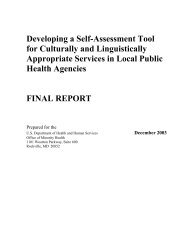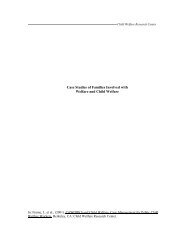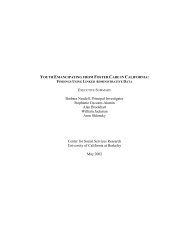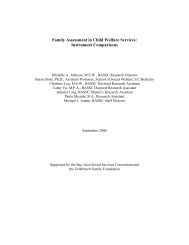Predictors of Resilience in Maltreated and Nonmaltreated Latino ...
Predictors of Resilience in Maltreated and Nonmaltreated Latino ...
Predictors of Resilience in Maltreated and Nonmaltreated Latino ...
You also want an ePaper? Increase the reach of your titles
YUMPU automatically turns print PDFs into web optimized ePapers that Google loves.
<strong>in</strong>formation regard<strong>in</strong>g the ethnic representation <strong>of</strong> their participants,<br />
<strong>and</strong> <strong>in</strong> those studies, the mean percentage <strong>of</strong> study participants<br />
reported to be Lat<strong>in</strong>o was 7% (Behl et al., 2001).<br />
As suggested by Cohen, Debl<strong>in</strong>ger, Mannar<strong>in</strong>o, <strong>and</strong> de Arellano<br />
(2001), m<strong>in</strong>ority children who have been abused may be at greater<br />
risk for develop<strong>in</strong>g more detrimental sequelae <strong>of</strong> child maltreatment<br />
than are maltreated children from more ma<strong>in</strong>stream cultures.<br />
Although few studies <strong>of</strong> Lat<strong>in</strong>o children have <strong>in</strong>vestigated the<br />
deleterious effects <strong>of</strong> different types <strong>of</strong> child maltreatment, several<br />
studies have demonstrated greater rates <strong>of</strong> behavioral problems,<br />
depressive symptoms, self-esteem issues, <strong>and</strong> emotional trauma<br />
among sexually abused African American <strong>and</strong> Lat<strong>in</strong>o children than<br />
among European American sexually abused children (Morrow &<br />
Sorrell, 1989; Russell, 1986; S<strong>and</strong>ers-Phillips, Moisan, Wadl<strong>in</strong>gton,<br />
Morgan, & English, 1995; Ste<strong>in</strong>, Gold<strong>in</strong>g, Siegel, Burnam, &<br />
Sorenson, 1988). For <strong>in</strong>stance, a study <strong>of</strong> African American <strong>and</strong><br />
Lat<strong>in</strong>a sexually abused girls by S<strong>and</strong>ers-Phillips <strong>and</strong> colleagues<br />
(1995) found higher rates <strong>of</strong> depression among sexually abused<br />
Lat<strong>in</strong>a girls than among sexually abused African American girls <strong>of</strong><br />
the same socioeconomic background. Compared with African<br />
American girls, Lat<strong>in</strong>a girls were more likely to have been sexually<br />
abused by a family member, experienced lower self-esteem <strong>and</strong><br />
feel<strong>in</strong>gs <strong>of</strong> <strong>in</strong>adequacy, <strong>and</strong> received less maternal support after<br />
disclosure <strong>of</strong> the abuse.<br />
Thus, prior <strong>in</strong>vestigations <strong>of</strong> maltreated Lat<strong>in</strong>o children (primarily<br />
sexually abused children) have demonstrated that these children<br />
are at high risk for maladaptive outcomes (e.g., depression, behavior<br />
problems; Morrow & Sorrell, 1989; Russell, 1986; S<strong>and</strong>ers-<br />
Phillips et al., 1995; Ste<strong>in</strong> et al., 1988). Because very little is<br />
known about the predictors <strong>of</strong> developmental outcomes <strong>in</strong> general<br />
<strong>and</strong> <strong>of</strong> resilient outcomes <strong>in</strong> particular <strong>in</strong> Lat<strong>in</strong>o children, it is<br />
imperative that we beg<strong>in</strong> to evaluate what processes may contribute<br />
to resilient function<strong>in</strong>g <strong>in</strong> both maltreated <strong>and</strong> nonmaltreated<br />
Lat<strong>in</strong>o children.<br />
<strong>Resilience</strong> is conceptualized as a dynamic process that <strong>in</strong>fluences<br />
an <strong>in</strong>dividual’s capacity to adapt <strong>and</strong> function successfully<br />
despite experienc<strong>in</strong>g chronic stress <strong>and</strong> adversity; it does not<br />
represent a personality trait or other static condition (Egel<strong>and</strong>,<br />
Carlson, & Sroufe, 1993; Luthar, 2003; Luthar, Cicchetti, &<br />
Becker, 2000). Although previous studies <strong>of</strong> resilience <strong>in</strong> maltreated<br />
children have not focused solely on Lat<strong>in</strong>o children, a prior<br />
<strong>in</strong>vestigation <strong>of</strong> predictors <strong>of</strong> resilient adaptation evaluated multiple<br />
areas <strong>of</strong> function<strong>in</strong>g <strong>in</strong> a heterogeneous sample <strong>of</strong> economically<br />
disadvantaged maltreated children <strong>and</strong> nonmaltreated comparison<br />
children (Cicchetti, Rogosch, Lynch, & Holt, 1993).<br />
<strong>Maltreated</strong> children were rated as more disruptive–aggressive <strong>and</strong><br />
more withdrawn, had significantly greater levels <strong>of</strong> <strong>in</strong>ternaliz<strong>in</strong>g<br />
behavior problems, <strong>and</strong> ev<strong>in</strong>ced lower overall competence on the<br />
<strong>in</strong>dices <strong>of</strong> function<strong>in</strong>g that were assessed than nonmaltreated children.<br />
However, among the maltreated children, ego-resiliency,<br />
ego-overcontrol, <strong>and</strong> positive self-esteem were found to be predictors<br />
<strong>of</strong> resilient adaptation. In contrast, among the nonmaltreated<br />
children, only ego-resiliency <strong>and</strong> positive self-esteem were<br />
predictive <strong>of</strong> resilient adaptation. Likewise, <strong>in</strong> a 3-year longitud<strong>in</strong>al<br />
study <strong>of</strong> another heterogeneous sample, Cicchetti <strong>and</strong> Rogosch<br />
(1997) demonstrated that <strong>in</strong> maltreated, socioeconomically disadvantaged<br />
children, factors such as positive self-esteem, egoresiliency,<br />
<strong>and</strong> ego-overcontrol predicted resilient function<strong>in</strong>g,<br />
whereas <strong>in</strong> nonmaltreated children, relationship features, as well as<br />
ego-resiliency, proved to be more <strong>in</strong>fluential.<br />
PREDICTORS OF RESILIENCE IN LATINO CHILDREN<br />
339<br />
Intellectual function<strong>in</strong>g is another factor that may predict resilience<br />
among high-risk children. Prior <strong>in</strong>vestigations have shown<br />
that <strong>in</strong>tellectual function<strong>in</strong>g, as typically measured by <strong>in</strong>telligence<br />
tests, not only predicts academic achievement but also may serve<br />
as a protective factor aga<strong>in</strong>st the development <strong>of</strong> antisocial behavior<br />
problems (Garmezy, Masten, & Tellegen, 1984; Luthar, 1991;<br />
Masten et al., 1999; White, M<strong>of</strong>fitt, & Silva, 1989). High <strong>in</strong>tellectual<br />
abilities may be associated with normal bra<strong>in</strong> function<strong>in</strong>g<br />
<strong>and</strong> cognitive development despite the experience <strong>of</strong> adversity<br />
(Curtis & Cicchetti, 2003). Furthermore, high <strong>in</strong>tellectual ability<br />
may <strong>in</strong>dicate effective <strong>in</strong>formation-process<strong>in</strong>g skills that a highrisk<br />
child may use when cop<strong>in</strong>g with environmental hardships,<br />
<strong>in</strong>clud<strong>in</strong>g better problem-solv<strong>in</strong>g skills <strong>and</strong> the ability to attract the<br />
<strong>in</strong>terest <strong>of</strong> teachers <strong>and</strong> improve school function<strong>in</strong>g (Masten &<br />
Coatsworth, 1998). In a study conducted by Herrenkohl, Herrenkohl,<br />
<strong>and</strong> Egolf (1994), average or above average <strong>in</strong>tellectual<br />
performance was found to be an <strong>in</strong>dividual factor that contributed<br />
to ongo<strong>in</strong>g competent function<strong>in</strong>g <strong>in</strong> a longitud<strong>in</strong>al <strong>in</strong>vestigation <strong>of</strong><br />
maltreated <strong>and</strong> nonmaltreated children. Because previous studies<br />
have shown that there is a l<strong>in</strong>k between <strong>in</strong>tellectual function<strong>in</strong>g<br />
<strong>and</strong> positive developmental outcomes, <strong>in</strong> the present <strong>in</strong>vestigation<br />
we exam<strong>in</strong>ed the role <strong>of</strong> <strong>in</strong>tellectual function<strong>in</strong>g as a predictor <strong>of</strong><br />
resilience <strong>in</strong> Lat<strong>in</strong>o children.<br />
Despite the fact that past research has sought to identify predictors<br />
<strong>of</strong> resilient adaptation <strong>in</strong> maltreated children, current studies<br />
have not conducted with<strong>in</strong>-group analyses <strong>of</strong> maltreated Lat<strong>in</strong>o<br />
children, <strong>and</strong> it is not known if the same predictive factors <strong>of</strong><br />
resilience would be applicable to this group. For <strong>in</strong>stance, <strong>in</strong> many<br />
Lat<strong>in</strong>o cultures, relationships are extremely valued <strong>and</strong> considered<br />
<strong>of</strong> central importance (Harrison, Wilson, P<strong>in</strong>e, Chan, & Buriel,<br />
1990). Yet it is not known whether relationship features would<br />
serve as predictors <strong>of</strong> resilient adaptation for both maltreated <strong>and</strong><br />
nonmaltreated Lat<strong>in</strong>o children. In other diverse populations, the<br />
ability to form relationships with others has been shown to promote<br />
resilience (Luthar, 2003; Masten & Coatsworth, 1998). In<br />
addition, <strong>in</strong> a sample <strong>of</strong> high-risk children, Werner (1993) identified<br />
protective factors associated with the development <strong>of</strong> resilience<br />
<strong>in</strong> Hawaiian children followed over the course <strong>of</strong> a 32-year<br />
longitud<strong>in</strong>al study. One <strong>of</strong> the important f<strong>in</strong>d<strong>in</strong>gs <strong>of</strong> that <strong>in</strong>vestigation<br />
was that the ability to establish <strong>and</strong> seek out emotional<br />
support systems that extended beyond the immediate family network<br />
promoted resilience <strong>in</strong> adulthood. That is, external support<br />
systems served as a protective factor for high-risk Hawaiian children<br />
<strong>and</strong> made a significant impact on the development <strong>of</strong> resilience<br />
over time. To date, it is unknown whether this pattern would<br />
emerge <strong>in</strong> a sample <strong>of</strong> high-risk, socioeconomically disadvantaged,<br />
maltreated <strong>and</strong> nonmaltreated Lat<strong>in</strong>o children.<br />
Likewise, there is very little known about the role <strong>of</strong> gender <strong>in</strong><br />
developmental outcomes among maltreated Lat<strong>in</strong>o children. Previous<br />
literature has suggested that gender may <strong>in</strong>fluence responses<br />
to adversity; specifically, it has been noted that girls may be less<br />
reactive to family stress than boys, <strong>and</strong> they may be less at risk for<br />
develop<strong>in</strong>g externaliz<strong>in</strong>g responses (Emery & O’Leary, 1982; Fergusson<br />
& Horwood, 2001; Hether<strong>in</strong>gton, 1989; Porter & O’Leary,<br />
1980). However, to our knowledge, no <strong>in</strong>vestigations have exam<strong>in</strong>ed<br />
whether gender <strong>in</strong>fluences resilient function<strong>in</strong>g among Lat<strong>in</strong>o<br />
children or the impact <strong>of</strong> cultural sex roles <strong>in</strong> predict<strong>in</strong>g resilience.<br />
Because traditional sex roles such as machismo (a man who carries<br />
himself with respect, responsibility, <strong>and</strong> honor) <strong>and</strong> marianismo (a<br />
woman who is self-sacrific<strong>in</strong>g <strong>and</strong> virtuous) are prom<strong>in</strong>ent <strong>in</strong>

















